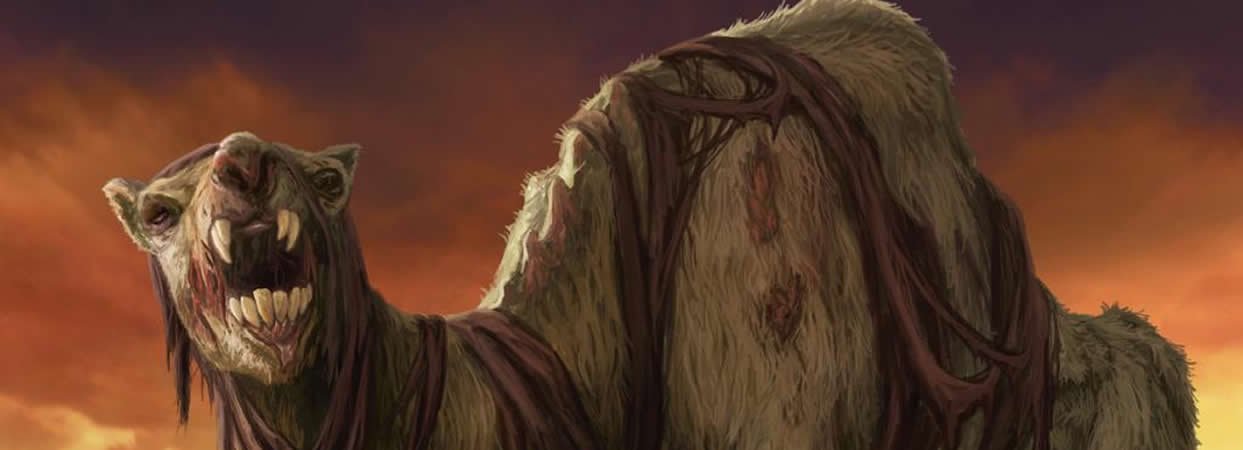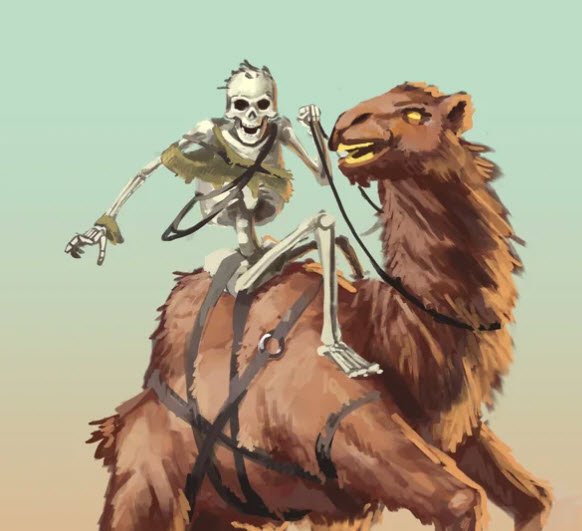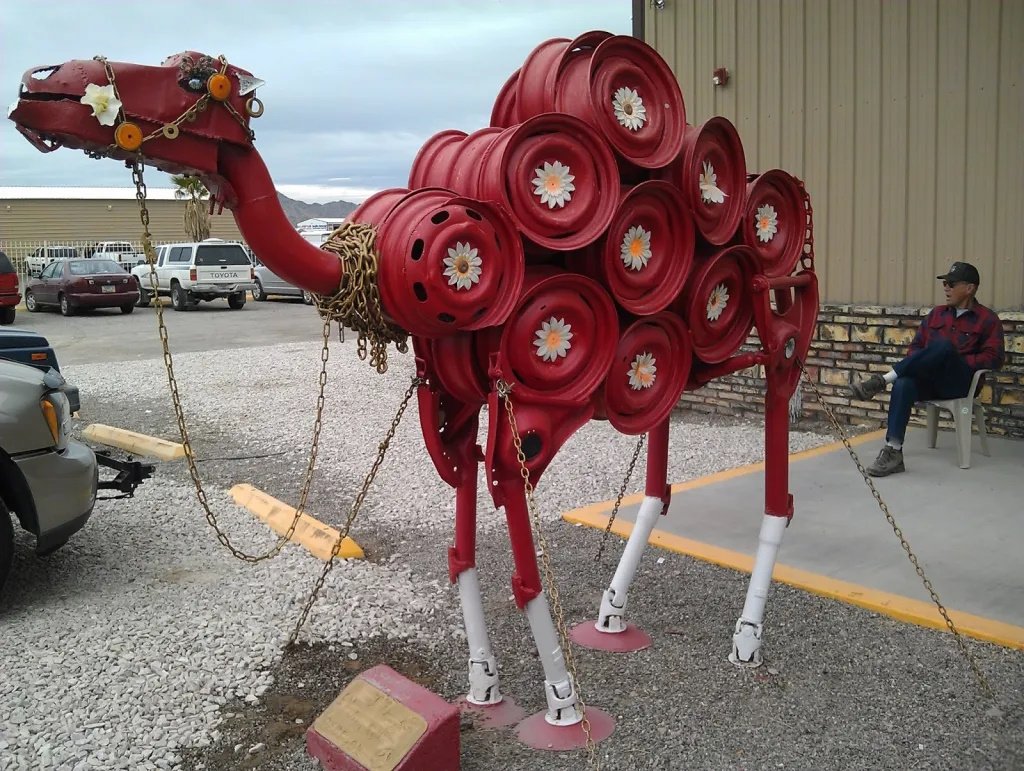A Tale of Terror

JANUARY 27, 2021 NICK MCDONALD This tale was originally featured in Episode 004
The Red Ghost terrorized Arizona during the 1880’s. The first reported appearance is in 1883, when it trampled a woman to death and left traces of red hair stuck to nearby tall grass at the scene. Later, a cowboy tried to rope the beast, but it turned and charged him, killing the man and his mount. A group of miners pursued it along the Verde River. It evaded capture, but shook something loose off of its back, a rotted human skull with dried skin and patches of hair stuck to it.
As sightings continued, the legend grew. Most described it as a great red demon with the devil himself riding on its back. Some witnesses claimed it was 30 feet tall. Other stories said that it had fought and devoured a grizzly, and that it could vanish before your eyes.
The Red Ghost’s reign of terror finally ended when a rancher in Eagle Creek caught it feasting on vegetables in his garden and shot at it, killing it dead. It was then that the Ghost’s true nature was revealed. It was a large camel, with gruesome straps of rawhide criss-crossing and digging into its body. The rawhide straps were apparently used to lash a human body, now in extreme decay, to the camel’s back. But how did such a creature in up in late 19th century Arizona?
For that answer, we have to go back decades, to a pre-Civil War America. In 1853, Secretary of War and future Confederate president, Jefferson Davis got approval from Congress, after much lobbying, to spend $30,000 on the importation of camels and dromedaries for military purposes. This was still decades before the transcontinental railroad, and Davis saw the camels as the key to westward expansion, especially through the arid southwest deserts. By 1857, 75 camels had been imported to America under the plan. Unfortunately, within a decade the initiative would be scrapped and all camels auctioned off.
Despite its epitaph, the program was largely successful. The camels were stationed with a U.S. Army at Camp Verde in Texas. The camels’ primary use was to strengthen current travel routes and poke and prod out new ones west to the Pacific and south to Mexico.
Two dozen of these camels made the famous trek to Fort Tejon outside Los Angeles under the usage of hero of the west Edward Beale. Beale’s troupe made the 1500 mile trek in just three months, a feat considered impossible at the time. The route discovered by Beale’s camel caravan was used to create the Beale Wagon Road, guiding thousands of settlers out west, and parts were adopted to make the Santa Fe Railroad’s contribution to the transcontinental railroad, and eventually Route 66 and Interstate 40.
The camels did have downsides, though. They were renowned for scaring the hell out of the horses, and given half-a-chance would just wander off overnight. Of course, this is all to say nothing of a pack animal that can spit with pinpoint accuracy at any handler it doesn’t agree with.
But the real straw that broke the camel program’s back came as Congress became afraid to pursue further importation of the animals due to pressure placed on them from lobbyists in the mule industry. Though this was plenty, further complications came from the secession of Texas and the South, causing Camp Verde to fall into the hands of the Confederacy. Left to Confederate care, the camels’ security was more lax, and many if them simply wandered off when let loose to graze.
The camel unit quickly scattered throughout the region. Union forces re-captured three of the beasts in Arkansas, but quickly auctioned then off. Some camels made it to Mexico, reportedly. A few found employment in the Confederate Postal Service. One, nicknamed Old Douglas, became the property of the 43rd Mississippi Infantry and was killed during the siege of Vicksburg, an act which so enraged Confederste Colonel Bevier that he tasked six of his best snipers with identifying and killing the Union sharpshooter that gunned Douglas down.
Some escaped camels turned feral and survived in the wilderness, but they never had enough numbers to provide a thriving and lasting sustainable herd. People would have chance encounters with these wild camels from time-to-time, the last report of such coming from the mid-20th century.
The origin of The Red Ghost himself is still something of a mystery. One rumor is that the rider was an Army soldier who was deathly afraid of the camels, so his fellow soldiers tied him to the back so he wouldn’t have to worry about falling off. Unfortunately, the beast took off and the soldiers were unable to keep up pursuit.
This seems a pretty poor explanation under scrutiny, though, because it relies on a soldier being tied on top in such a way that he couldn’t get himself off. It’s hard to image an arrangement under friendly intentions where the rider would not be given means to remove himself from the beast’s back.

Another tale tells of a rider that was too tired to hold onto the beast and decide to tie himself on instead, but again that would leave us a rider that should be able to get himself loose before death set in. A more likely incident might be a screwball episode of frontier justice, or maybe a death sentence created by a particularly creative and sadistic outlaw, either one a situation where an individual would be attached to an animal without means of removing themselves, then the animal set loose with no destination in mind. Whatever the story, the rider’s fate and identity were never discovered. And despite The Red Ghost’s capture and killing, reports of a red camel being ridden by a skeleton persisted for years afterwards.
Today, a bright red scrap metal sculpture of The Red Ghost sits in Quartzside, AZ, where it has been lovingly named Georgette. Old Douglas has a grave in Cedar Hill Cemetery in Vicksburg, Mississippi, somehow fittingly as it’s Jefferson Davis’s hometown.
Interestingly enough, though, another ghost story has sprung forth from the history of these imported camels. Three camels were purportedly purchased from an Army auction by a prospector by the name of Jake. The soldiers warned Jake that the camels were quite ornery, but Jake took good care of them and never had anything but praise for them and their behavior.
Eventually, Jake hit pay dirt and led his camels into town, laden in gold for the exchange. This caught the attention of a would-be claim jumper named Paul Adams. He heard of Jake’s success and decided to follow him and his camels out of town.
Jake was smart enough to not head directly to his claim, and instead took a long, circular route, so long that he ended up having to camp for the night. Mistaking the temporary camp site for the actual gold claim, Adams snuck in and murdered Jake. Trying to protect his owner, one of the camels attacked Adams, biting him, but eventually getting gunned down as well.
It wasn’t long before Adams realized his mistake, that this wasn’t the claim, and spent the next few days searching the nearby area, vainly trying to locate the real spot. It was on one night of searching that Paul Adams was awoken and saw the ghost of Jake on the back of his camel looking over the murderer. He quickly mounted his horse and fled, but the galloping camel continued the chase, unrelenting until Adams rode into town. Adams was so frightened he confessed all his deeds in exchange for the protection of a sheriff’s jail cell.🌵
